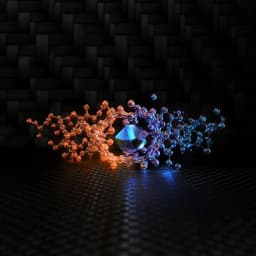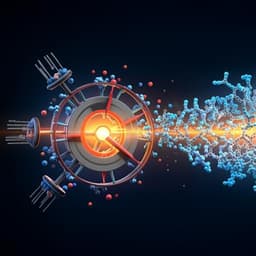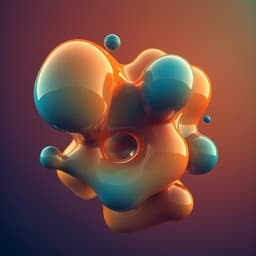
Engineering and Technology
Breaking solvation dominance of ethylene carbonate via molecular charge engineering enables lower temperature battery
Y. Chen, Q. He, et al.
Explore the groundbreaking research by Yuqing Chen and colleagues that reveals a modified electrolyte designed to enhance lithium-ion battery performance at frigid temperatures. With remarkable ionic conductivity at -90 °C and unmatched functionality around -100 °C, this innovation could transform battery technology in extreme conditions.
~3 min • Beginner • English
Introduction
Lithium-ion batteries for extreme environments require electrolytes that remain liquid over wide temperature ranges and support fast ion transport and charge transfer at low temperature. At low temperature (≤0 °C), charge transfer processes dominated by Li⁺ desolvation barriers limit performance, leading to lithium plating and unstable solid electrolyte interphases (SEIs). Conventional EC-based electrolytes exhibit strong coordination between Li⁺ and the carbonyl oxygen of high-permittivity EC, raising desolvation energy. The research goal is to weaken Li⁺–solvent interactions while preserving the benefits of high-permittivity solvents. The authors hypothesize that reducing the electronegativity of the carbonyl oxygen in a high-ε environment—via introducing strongly electron-withdrawing fluorine in a low-melting carboxylate cosolvent—can unlock EC from Li⁺ solvation, shift the primary solvation shell from EC-dominated to low-ε solvent (DEC)-dominated, and thereby reduce desolvation energy, improve conductivity and liquidity, and enable low-temperature operation.
Literature Review
Multiple electrolyte strategies have been explored to improve low-temperature performance: liquefied gas electrolytes; novel co-solvents; highly fluorinated solvents; propylene carbonate (PC)-based systems; localized high-concentration electrolytes (LHCEs); weakly solvating electrolytes; and cointercalation approaches. These typically increase anion participation in Li⁺ solvation by replacing EC with low-ε solvents. LHCEs, in particular, use low-polarity fluorinated ether diluents to break strong solvent interactions, broadening liquid range and aiding desolvation. However, EC-free or low-ε-only approaches often reduce conductivity and overlook direct Li⁺–high-ε solvent interactions, limiting performance at extremely low temperatures (≤ −60 °C). The authors propose an alternative: maintain high-ε EC but weaken its Li⁺ coordination by fluorination effects in a carboxylate cosolvent (ethyl butyrate derivatives), leveraging dipole–dipole interactions to reduce EC binding while promoting low-ε solvent (DEC) coordination.
Methodology
Electrolyte design and preparation: A base electrolyte of 1 M LiPF₆ in EC:PC:DEC:EMC = 2:1:3:4 (vol) was compared with test electrolytes of the same salt concentration in EC:PC:DEC:EMC:cosolvent = 2:1:1.5:4:1.5 (vol), replacing half of DEC with one cosolvent: ethyl butyrate (EB) or its fluorinated analogues 4,4,4-ethyl trifluorobutyrate (ETFB), ethyl heptafluorobutyrate (EHFB), and 2,2,2-trifluoroethyl butyrate (TFEB). Cosolvent selection emphasized low melting point and tunable fluorination degree/site.
Physical characterization: Conductivity measured from −90 to +70 °C (VFT fitting for activation energies); viscosity and DSC for freezing/melting behavior; visual liquidity at −110 °C. FTIR (C=O region) and Raman (EC ring and C–O vibrations) were collected temperature-dependently to quantify solvated vs free species and EC vs DEC coordination ratios.
Computations: DFT (Gaussian16, B3LYP/6-311G(d,p), SMD with acetone) for binding energies and desolvation energy of Li⁺ solvation clusters, and frontier orbital energies; MD simulations (Materials Studio, COMPASS III, Nosé thermostat) to obtain RDFs and coordination numbers for Li⁺ with solvents/anions at 25 °C and −70 °C.
Electrochemical testing: EIS and Distribution of Relaxation Times (DRT) analysis from −60 to 80 °C to separate charge-transfer resistance (Rct) and SEI resistance (RSEI), and evaluate activation energies (Arrhenius fits). Cycling and rate tests performed on coin cells (NCM811/Li, LCO/Li, Gr/Li) and commercial 1 Ah pouch cells (NCM811/Gr and LCO/Gr) with 3.0–4.5 V windows under low-temperature protocols: RT charge–LT discharge and LT charge–LT discharge. Safety assessed via Accelerating Rate Calorimetry (ARC).
Interfacial analyses: TOF-SIMS depth profiling for SEI composition and spatial distribution (organic fragments and LiF-rich inorganic species), Co dissolution/crossover mapping; XRD for lithium metal detection on graphite; XPS and SEM/TOF-SIMS imaging for lithium dendrite identification and morphology after LT cycling.
Cell fabrication: 1 Ah pouch cells (Li-Fun Technology) with specified cathode/anode loadings; electrolyte fill: 4.3 g (NCM811/Gr) and 2.1 g (LCO/Gr). Instrumentation and parameters detailed for spectroscopy and electrochemistry.
Key Findings
- Molecular charge engineering via fluorinated ethyl butyrate cosolvents weakens Li⁺–solvent interactions and shifts the solvation shell from EC-dominated to DEC-dominated, especially at low temperature, while retaining EC’s high permittivity benefits.
- Physical properties: EHFB electrolyte remains liquid after 30 min at −110 °C; exhibits ionic conductivity of 1.46 mS cm⁻1 at −90 °C and a low VFT-derived activation energy of 0.98 eV (vs base: frozen by −50 °C and 0.001 mS cm⁻1 at −90 °C). Estimated freezing points: EHFB −135 °C, TFEB −132 °C, ETFB −130 °C.
- Solvation structure (MD at 25 °C): Base electrolyte Li⁺ coordination numbers: EC 1.31, DEC 1.13, EMC 0.94. With EHFB: EC drops to 0.61; DEC rises to 1.46; cosolvent coordination decreases with higher fluorination (EB 1.3 → EHFB 0.06). At −70 °C in EHFB: DEC increases to 1.71; EC decreases to 0.33; EHFB participation increases (0.56). FTIR-derived ratios R₁ (solvated EC/free EC) and R₂ (solvated DEC/solvated EC) decrease with temperature, confirming DEC-dominant solvation at LT; Raman blueshifts suppressed vs base.
- Energetics (DFT): Li⁺ desolvation energy decreases with fluorination degree: 4EC 1.1 eV; EC–2DEC–EB 1.0 eV; EC–2DEC–ETFB 0.93 eV; EC–2DEC–EHFB 0.83 eV. Fluorination induces a dipole redistribution reducing EC–Li⁺ binding and promoting DEC coordination.
- Kinetics (DRT/EIS): At −60 °C, Rct: EHFB 1.0 Ω, TFEB 3.2 Ω, ETFB 4.7 Ω vs base 8.8 Ω. Charge-transfer activation energy in LCO/Gr pouch cells: EHFB 10.9 kJ·mol⁻1 vs base 30.4 kJ·mol⁻1. SEI transport activation energy: EHFB 19.8 kJ·mol⁻1 vs base 29.3 kJ·mol⁻1. Graphite anode impedance dominates at LT; EHFB markedly lowers Rct and stabilizes RSEI over cycles.
- SEI/interfacial chemistry (TOF-SIMS): EHFB drives more LiF-rich, inorganic-rich inner SEI and suppresses EC reduction at LT, enhancing DEC and cosolvent reduction contributions. Increased LiF species with decreasing temperature; reduced Co dissolution/crossover at both RT and LT vs base.
- Low-temperature electrochemistry (1 Ah pouch cells, 4.5 V):
• Cycling at −10 °C (200 cycles): NCM811/Gr capacity retention 97.94%; LCO/Gr 86.70%; CE ~99.6%/99.5%.
• LT charge capability: NCM811/Gr delivered 364 mAh after charge at −60 °C; cells with base electrolyte failed below −30 °C.
• RT charge–LT discharge: LCO/Gr retained 830 mAh at −40 °C (73.9% of RT); ~60% of RT capacity at −70 °C; NCM811/Gr retained 61% at −70 °C. Discharge functionality preserved even at ~−100 °C after RT charging.
• One-cycle charge/discharge at −60 °C retained 334 mAh.
- Graphite anode behavior: EHFB suppresses lithium dendrites at LT. Base electrolyte shows metallic Li (XRD peak at 35.8°, XPS at ~52.2 eV), significant plating peaks (dV/dQ), and dendritic morphology (SEM/TOF-SIMS); EHFB case does not. Gr/Li cells with EHFB retain 95% (−20 °C) and 57% (−70 °C) of RT charge capacity under RT discharge; stable cycling at −10 °C with 99% retention over 120 cycles.
- Safety (ARC, LCO/Gr): EHFB significantly lowers max dT/dt to 5.1 °C s⁻1, raises thermal runaway temperature to 226 °C, and reduces maximum temperature to 309 °C, indicating improved safety.
Discussion
The study directly addresses the central challenge of high desolvation barriers and poor charge transfer at low temperatures in EC-based electrolytes by engineering the solvation shell. Fluorinated ethyl butyrate cosolvents reduce the carbonyl oxygen electron density and alter dipole interactions, thereby weakening EC–Li⁺ coordination and enabling a transition to DEC-dominated solvation while involving the cosolvent at low temperatures. This overall weaker solvation lowers desolvation energy and charge-transfer resistance, broadens the liquidity window, and improves ionic conductivity at extreme cold. Concurrently, the fluorinated cosolvent promotes formation of a LiF-rich, robust SEI, diminishes transition-metal dissolution/crossover, and reduces SEI transport barriers. Collectively, these effects translate into markedly enhanced low-temperature performance in commercial-scale pouch cells, suppression of lithium dendrites on graphite, and improved safety, validating the proposed molecular charge engineering approach for EC-based electrolytes.
Conclusion
Introducing fluorinated ethyl butyrate cosolvents into traditional EC-based electrolytes unlocks EC from Li⁺ solvation and establishes a DEC-dominated, weakly coordinated solvation shell. This fluorination-dependent solvation redesign delivers: a vastly widened liquid range (liquid at −110 °C), high ionic conductivity (1.46 mS cm⁻1 at −90 °C), lowered desolvation and charge-transfer barriers, LiF-rich robust SEIs, dendrite suppression on graphite, excellent low-temperature discharge capability down to −100 °C after RT charging, and stable cycling at −10 °C in 1 Ah, 4.5 V graphite-based pouch cells. The work provides a broadly applicable strategy to realize all-temperature lithium-ion batteries without abandoning EC’s high-permittivity advantages. Future research may optimize fluorination patterns and cosolvent structures, explore compatibility with various salts/cathodes, and scale manufacturing while maintaining safety and performance in extreme conditions.
Limitations
The authors note that achieving sustained cycling below −60 °C remains challenging. The study focuses on specific EB-derived fluorinated cosolvents and LiPF₆-based carbonate systems; broader generalization to other salts/solvents and long-term cycling performance at ultra-low temperatures requires further investigation.
Related Publications
Explore these studies to deepen your understanding of the subject.







